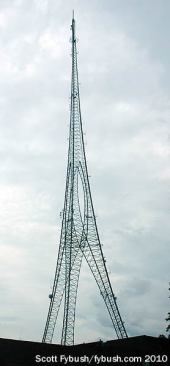Panoramio
My mother used to say that transmission, electrical, and broadcast towers were our 20th-century monuments. A teacher who was trained as an artist, my mom liked to provoke. But she had a point. Last week, I wrote about the blandness of at least one current example of this art of engineering: 1 World Trade Center. It reminded me of what I think of as a true masterpiece of the genre, the Star Tower in my native Cincinnati. Sited on a ridge just west of the one my house occupies, I see it almost every day, and it never ceases to thrill me.
As is the case with many such feats of engineering, it is difficult to find out more about this structure, beyond the fact that it was designed and built by the Landmark Tower Company, then based in Fort Worth, Texas. As far as I can tell (and I put my crack students at the University of Cincinnati to work on this as well), the designer was somebody anonymous who worked for that company, which no longer seems to exist. We do know that somebody, whether it was in the company or among clients, liked the design, for the same tower appears, at different heights, in Mesquite, Texas; Washington, D.C.; and Poor Mountain, Va.
What makes the towers of this model so beautiful is that whomever did design them had the eye of a sculptor and the brain of an engineer. Star Tower is a tripod, its three legs rising to meet each other about a third of the way up its almost-1,000-foot height. These shapes taper down from larger footings to a thinner middle and then expand again as they meet. The top cords continue all the way up the top in one swoop, but the bottom three loop around into each other, describing a central, ovoid and voided core.
I am sure that that opening has both a functional and an economic reason for being there: It gives the wind less to blow against while minimizing the amount of steel needed in the construction. Its effect is what matters most to me. It turns the simple form into a sculpture whose lines move in a fluid play of intersecting arcs, reaching towards each other, dancing around that middle torso, and then finally thrusting up towards the top.
When you look at the Star Tower from a distance, which, given its scale and location in a sparsely populated pocket of this city’s West Side, is the usual mode of observation, it is more unified as a shape, but you still sense both a lightness and a sense in which it moves without any seeming effort from an unseen base to the tip where its blinking red light denotes marks its height and reminds us of its function.
Transmission towers are becoming relics of the past. More and more of us now receive our signals from cables or satellites, and the cellular coverage we need camouflages itself on roof tops or as fake fir trees. In the Midwest, these towers are reminders of a culture that drew us together around shared baseball games, comedies, or news reports, rather than fragmenting this information into hundreds and thousands of different outlets or channels.
So the Star Tower is a monument—though it is still in operation. It sits in our landscape, reminding us of a particular part of our past, while acting as a marker that helps us orient ourselves in both time and space. It does so with greater success than any such object in the region because of its design elegance. This for me begs the question: If my mother was right, then what will be the monuments of the 21st century? Will we even have any? For now, I look toward Star Tower and remember both my mother and the time and the sense of place for which this piece of sculpture stands.


